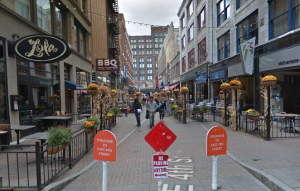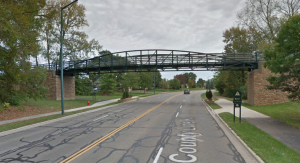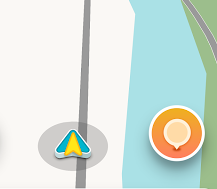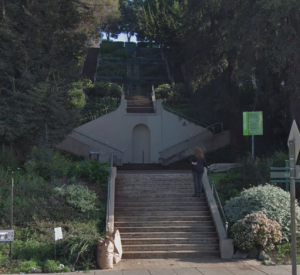
Pedestrian paths (US English) or walking trails (default English) are a set of non-drivable road types with unique properties. It is possible to connect them to other roads using a virtual node rather than a real junction node. The virtual node does not cut the segment that it is connected to but modifies it. It doesn't store turn data, nor does it allow routing into a non-drivable road connected to it. Because of the presence of virtual nodes, it is not possible to convert segments between pedestrian path types and other road types. Therefore, they must be created as a category separate from other roads.
Use of these types requires special care and caution. This is because the Waze app is intended only for drivers of motor vehicles, and Waze has no plans ever to support any other application. In fact, cyclists and pedestrians who use Waze near drivable roads can harm routing for drivers! By Wazing at speeds different from nearby traffic, they can create false traffic indications and even influence Waze's records of average road and turn speeds. Therefore, editors should only map roads that increase usefulness to Wazers driving motor vehicles, and any road that only benefits non-driving Wazers should not be mapped. However, there are certain use cases for these paths, which are described under each section.
Note: As this is guidance for the USA, this page uses US English "translated" names for these road types. The default international English interface in Waze Map Editor uses different terms for these, which are given in parentheses.
Routable pedestrian path 
| | | | | | | | | |

The routable pedestrian path (default English: walking trail) is the only type among the three pedestrian paths that has an effect on routing, and it is only the only type that snaps users to it. This type should never be used where effects on routing are not desired.
If a routable pedestrian path is closest to a destination or start point of a route, users will be routed to or from a junction of the path with a drivable road, which can be far away from the destination they are hoping to reach, but not onto or through the routable path itself. Because of this, routable pedestrian paths can cause confusion and significant routing issues. Therefore, they should only be used in rare cases to improve routing to and from destinations located on them. Never use this type for ordinary hiking or cycling paths. Most hiking and cycling paths should not be on the map at all.
Applications
In rare cases, connected routable paths can bring drivers to destinations where otherwise Waze might fail to offer the best route. For example:
- A concert pavilion in an urban park accessed by a pedestrian path from a distant parking lot.
- A train station reachable from either side of the tracks but with no drivable road across them.
- A rest area accessible from both directions of a freeway but with separate and unconnected parking lots.
- A destination addressed on a non-drivable footpath.
A connected routable pedestrian path may be used to route drivers to such destinations. Lock the path as this is uncommon usage that may puzzle other editors.
Orientation or destination applications involving foot or bicycle paths that do not require routing, such as marking where an obvious bicycle path crosses a road or where a trailhead is located, should not use this type type. Use non-routable pedestrian paths, stairways or places as appropriate.
Creation
As of 2018-05[update] virtual nodes do not work correctly in routing. For desired routing these paths must be connected to junction nodes rather than virtual nodes. This may require cutting the drivable road segment with a normal street and deleting the street before creating the routable path. If destinations are addressed using house numbers on a routable pedestrian path, it is essential that the path's name and city fields be set accordingly so that routing to the addresses will work.
Non-routable pedestrian path
| | | | | | | | | |

Non-routable pedestrian paths (default English: pedestrian boardwalk) have no effect on routing and do not snap drivers to them, as drivable roads or routable pedestrian paths do. This makes them safe for use in mapping certain non-drivable roads as navigational references or for other special non-routing purposes.
Applications
thumb|leftThere are certain cases where mapping non-routable paths can benefit drivers. For example:
- A trail is visibly obvious and useful as a landmark in relation to a destination or turn.
- A trail has GPS tracks that show frequent improper Waze use. Mapping these indirectly benefits drivers as it protects speed history and real-time traffic data on nearby drivable roads.
- A trail is a significant destination in itself that people would drive to but without a discrete trailhead or access point.
Bike paths, hiking trails or other walkways that do not benefit drivers should not be mapped.
Creation
When non-routable paths had routing effects, most editors tended to disconnect them. Now that they don't have routing effects, they should be connected to drivable roads. If they are connected where no junction node exists, they will create a virtual node and will keep the segment intact. If they are connected at an existing road junction, they will be added to the junction node and will not create a virtual node. Either method of connection works correctly for non-routable paths; do not cut road segments just to connect a non-routable path. Name them with whatever name is found on signage or in official use.
Stairway 
| | | | | | | | | |


Stairways appear and behave identically in the app to non-routable pedestrian paths. They appear at similar zoom levels to private roads and parking lot roads, and they have no effect on routing. Certain public stairways are visually obvious and useful as destinations for drivers. These can be mapped using the stairway type. In general, the applications and methods of creation of non-routable pedestrian paths apply also to stairways.